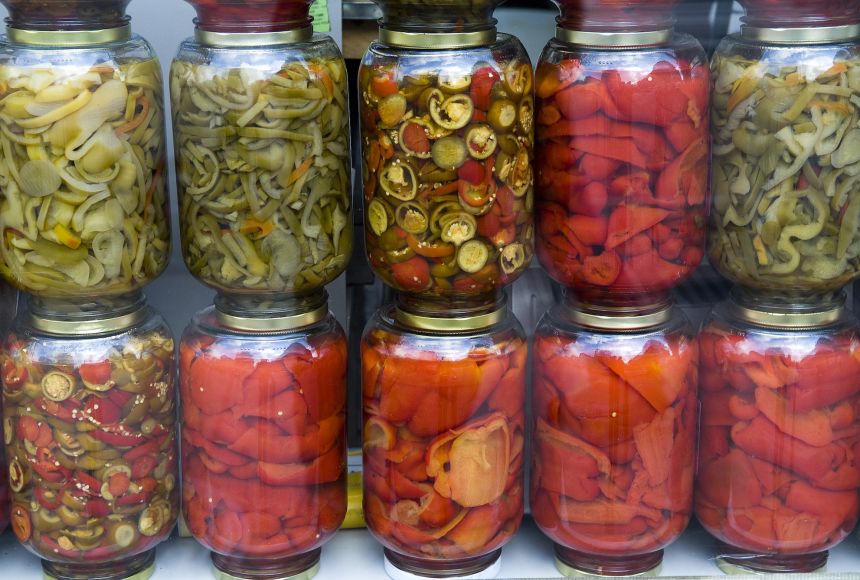I’m from northern Vermont, and am the descendant of a long line of uptight Puritans and taciturn ice fishermen. Chattiness is not our bag. At parties, we’re big on nail-biting reticence and we tend to have an over-developed concept of personal space. A lot of us, as kids, hid behind the couch when company came to call. Social anxiety, just possibly, may be in our genes.
Social anxiety, defined as the “persistent and overwhelming fear of social situations,” is the second most common anxiety disorder in the United States. At a guess, over 19 million Americans suffer from it—and ordinarily, you’d think we’d be able to support each other. After all, we should be fairly easy to spot: we’re the guys with the deer-in-the-headlights expressions, trying to hide behind the curtains.
But now there may be a simple solution. And it’s pickles.
Recent research from Virginia’s College of William and Mary and the University of Maryland shows that eating fermented food—such as yogurt, sauerkraut, pickles, and kimchi—markedly reduces social anxiety. The effect is especially pronounced in those whose nerves tip into neuroticism—that is, the chronically, fearfully, shy.
It’s been common knowledge for decades that our mental state affects our innards: Anxiety can bring on nausea or diarrhea; depression can make us lose (or gain) an appetite. Now, however, it’s becoming increasingly clear that the brain-to-gut pathway is a two-way street. Not only does the way we feel affect our digestive tracts, but the trillions of bacteria in our digestive tracts can dictate the way we feel.
Studies in mice indicate that the microbiome—that is, the immense population of bacteria that inhabits the body—plays an essential role in mental health. Bacteria-free mice, whose guts have been stripped of microbes, are anxious mice: analyses found that they have increased levels of the stress hormone cortisol, and decreased levels of BDNF (brain-derived neurotrophic factor), a protein associated with depression in humans. Further work showed that if the anxious mice were given the probiotic lactic acid bacterium Lactobacillus, stress hormone levels dropped and anxiety—and depression-related behaviors disappeared.
Researchers guess that probiotics—a.k.a. “good” bacteria—in fermented foods boost the production of GABA (gamma-aminobutyric acid), a chemical messenger in the brain that has the same effect as anti-anxiety medications. In other words, if you’ve got a case of social jimjams, eating a bowl of sauerkraut may be the equivalent of popping a Valium. Or maybe even better.
According to the National Institutes of Health’s Human Microbiome Project, bacterial cells in the average human body outnumber human cells by a factor of 10 to one; and the number of bacterial genes we’re toting around outnumbers ours by 360 to one. (The human genome contains about 22,000 genes; the microbiome collectively carries eight million.) Bacteria make up somewhere between one and three percent of our body weight. Up to two kilograms (four and a half pounds) of each 68 kilogram (150-pound) adult is bacteria.
And this is a good thing. We need these microbial hangers-on to digest our food. On our own, we simply don’t produce all the enzymes we need to break down many of the proteins, fats, and carbohydrates in our diets. Our resident microbes also manufacture beneficial compounds that our genome can’t provide, like vitamins and anti-inflammatory compounds; and they tweak our immune systems, and protect us from a range of chronic diseases.
The microbiome is complicated. Scientists of the Microbiome Project calculate that healthy people harbor thousands of different species of bacteria. If we mess up the balance among these—as may happen with diets heavy in processed foods and overexposure to antibiotics—we may, willy-nilly, not only plunge ourselves into miserable mental states, but predispose ourselves to allergies, asthma, obesity, Type 2 diabetes, and cardiovascular disease. As it is, the microbiomes of Americans and Europeans now appear to be less diverse—and therefore less versatile and resilient—than those of people in less-industrialized countries.
The benefit of fermented foods over commercially available probiotic supplements may be that foods, a complex jumble of components, are more likely to enhance microbiome diversity. The rule, when it comes to our body’s bacteria, seems to be the more, the merrier.
Which is why, if you’re attacked by nerves before a party, a speaking engagement, or a tough telephone call, try yogurt, kimchi, or pickled beets.
You just may need to beef up your microbes.
